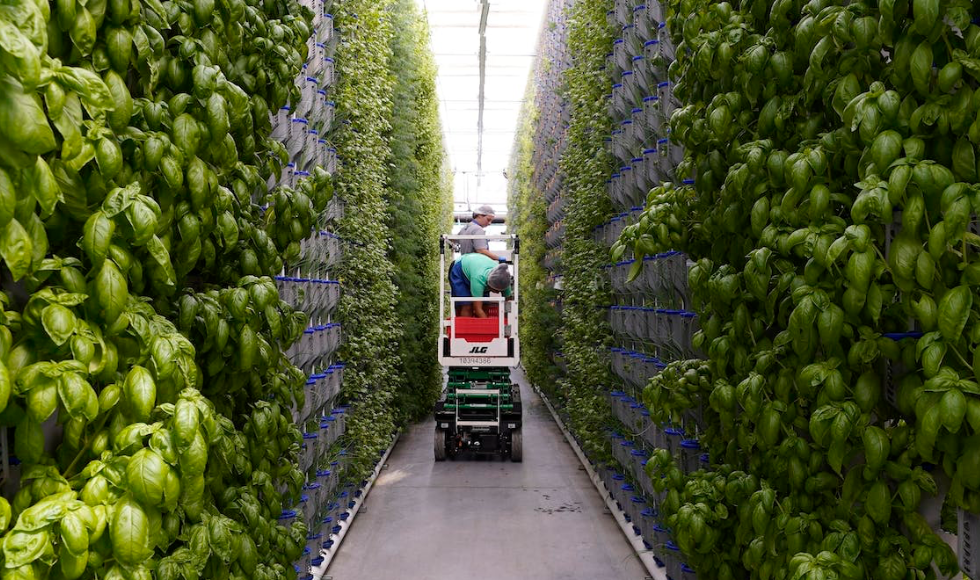Analysis: How digital twins will enable the next generation of precision agriculture

Workers use a lift to check herbs at a vertical farm greenhouse in Cleburne, Texas. (AP Photo/LM Otero)
BY Istvan David
November 24, 2023
Drastic climate change and overpopulation have rendered traditional agricultural practices unsustainable. Even more economically affluent countries suffer from constantly increasing household food insecurity.
In Canada, for example, one-in-six families find it difficult to provide food to maintain a healthy and active lifestyle, and the situation is getting worst year by year.
Food insecurity is a rapidly escalating global problem that challenges agriculture companies to find radically new ways to produce crops efficiently: with less waste, fewer pesticides and shorter time to market, while also reducing their energy footprint.
As traditional outdoor farming is unable to address these challenges, indoor farming techniques, such as controlled environment agriculture (CEA) are becoming of particular interest. However, they require proper computer-aided support. Such computer-aided methods and tools are developed in our lab on Sustainable Systems and Methods (SSM) at McMaster University.
Digital twins
CEA is the technique of growing crops in an isolated environment artificially controlled by complex machinery HVAC (heating, ventilation and air conditioning), irrigation and lighting systems, alongside an array of sensors to measure environmental conditions.
Thanks to automation, controlled environments achieve better yield and quality than traditional farming settings, while also reducing waste.
As these improvements come with increased complexity, finding the optimal growth strategy — that is, the sequence of environmental conditions that stimulate growth at the most appropriate pace and reduce energy consumption — is particularly challenging.
This is another complex challenge that requires continuous monitoring of the environment, real-time decision-making and high-precision control of the environment — tasks that are beyond the limits of human capabilities.
Computer-aided support, such as digital twins, can play an important role.
Digital twins are digital representations of physical objects, people or processes. They aid decision-making through high-fidelity simulations of the twinned physical system in real time and are often equipped with autonomous control capabilities.
In precision agriculture, digital twins are typically used for monitoring and controlling environmental conditions to stimulate crop growth at an optimal and sustainable rate.
Digital twins provide a live dashboard to observe the environmental conditions in the growing area, and with varying autonomy, digital twins can control the environment directly.
Reducing energy consumption — or rather, improving the crop-to-energy ratio — is one of the obvious goals at precision agriculture facilities as heating and cooling the facility consumes a lot of energy.
Digital twins can also be used for designing new greenhouses. For example, a digital twin that collected data over a long period in a greenhouse can be used for experimentation purposes when a new greenhouse is designed.
Is this economically feasible?
Developing digital twins and improving the digital maturity of farming companies are the main cost drivers in the adoption of digitally enhanced CEA.
The costs associated with the development of the digital twin are mostly related to hardware elements and software development. Home-brew solutions, experimentation with cheap devices and gradual expansion of functionality are good first steps and help adopt the right digitalization mindset.
However, professional grower settings require industry-grade sub-systems, which are in a completely different league in terms of costs, and employing them requires a carefully prepared organizational digital strategy.

Agriculture is among the lowest-digitalized sectors, and digital maturity is an absolute prerequisite to adopting digital twins. As a consequence, costs related to digital maturity often overshadow technical costs in smart agriculture.
A company undergoing the early stages of digitalization will have to think about choosing a cloud provider, establishing a data strategy and acquiring an array of software licences, to name just a few critical challenges.
Organizational costs are hard to assess, but they might render the economic outlook of a company bleak. This is a particularly painful growing stage that requires proper consulting.
There have been recent success stories of industrial-academic collaborations that helped scope ongoing digitalization efforts at agricultural companies.
What’s next?
The need for food security and sustainable production is as urgent as it’s ever been.
Amid dramatic climate change, forest fires all across Canada, extreme air pollution in Europe, an ongoing energy crisis and the continuous growth of population, food self-sufficiency is among the top goals of humankind.
Meeting the second sustainability development goal of the United Nations General Assembly — that is, to eradicate global hunger by 2030 — will require a complete paradigm shift in agriculture.
One way to meet this ambitious goal is by advanced digitalization and digital twins. There are still obstacles to tackle before we get there, but with the constantly decreasing price of hardware and computing power, digitally driven smart agriculture is becoming a reality.
Istvan David, Assistant Professor, Computer Science, McMaster University
This article is republished from The Conversation under a Creative Commons license. Read the original article.


